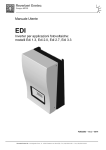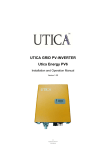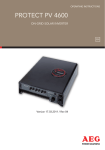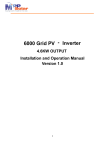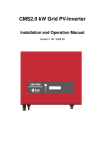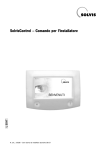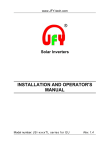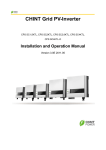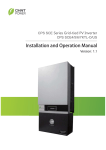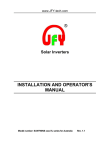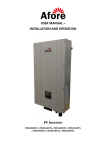Download 2. Safety Instructions
Transcript
Contents 1. Manual Instruction 1.1 Symbols used in this manual ........................................................................................................ 1 1.2 User group ................................................................................................................................... 2 1.3 Validity ......................................................................................................................................... 2 2. Safety Instructions 2.1 Intended use ................................................................................................................................ 2 2.2 Safety instructions ........................................................................................................................ 3 3. Unpacking 3.1 Scope of delivery .......................................................................................................................... 4 3.2 Identifying the Inverter .................................................................................................................. 4 4. Mounting the Device 4.1 Security ........................................................................................................................................ 5 4.2 Selecting the mounting location .................................................................................................... 5 4.3 Mounting instructions .................................................................................................................... 7 5. Electrical Connection 5.1 Connection Area Overview ........................................................................................................... 9 5.2 System Diagram ......................................................................................................................... 10 5.3 Cable Sizing ............................................................................................................................... 11 5.4 Connection of the PV generator (DC) .......................................................................................... 12 5.5 Connecting the inverter to the grid .............................................................................................. 13 5.6 Connecting communication cable ............................................................................................... 16 6. Switch on and off 6.1 Switch on ................................................................................................................................... 17 6.2 Switch off ................................................................................................................................... 17 7. Operation 7.1 Display Overview ........................................................................................................................ 18 7.2 LED display ................................................................................................................................ 18 7.3 LCD display ................................................................................................................................ 19 8. Troubleshooting 8.1 Display Message ........................................................................................................................ 23 9. Technical data ...................................................................................................................... 29 10. Appendix 10.1 Exclusion of liability................................................................................................................... 31 1. Manual Instruction 1.1 Symbols used in this manual This manual contains important instructions for safety and operation which must be understood and carefully followed during installation and maintenance of the equipment. In order to reduce the risk of electric shock and to be sure that the equipment is correctly installed and ready to operate, special safety symbols are used in the manual to highlight potential safety risks or useful information. The symbols are the following: DANGER! DANGER indicates a hazardous situation which, if not avoided, will result in death or serious injury. WARNING! WARNING indicates a hazardous situation which, if not avoided, could result in death or serious injury. CAUTION! CAUTION indicates a hazardous situation which, if not avoided, could result in minor or moderate injury. NOTICE NOTICE indicates a situation which, if not avoided, could result in property damage. Information Information provides tips that are valuable for the optimal installation and operation of your product. <<1 1.2 User group This manual is for electrically skilled persons. The tasks described in this manual may only be performed by electrically skilled persons. 1.3 Validity This manual applies to EA1KLPV/EA1K5LPV/EA2KLPV grid-connected inverter and describes the mounting, installation, commissioning, maintenance and troubleshooting procedures. Keep this manual in a convenient place for future reference. 2. Safety Instructions 2.1 Intended use EA1KLPV/EA1K5LPV/EA2KLPV is a PV inverter, which converts the direct current of the PV array to grid-compliant alternating current and feeds it into the power distribution grid. PV grid-connected system consists of PV modules, grid-connected inverters, metering device and power distribution system (Figure 1). PV modules Combiner box Inverter Metering Power grid Figure 1 PV grid-connected system 2>> The EA1KLPV/EA1K5LPV/EA2KLPV series inverter is suitable for indoor and outdoor use and may only be operated with PV arrays (PV modules and cabling) of protection class II... Do not connect any sources of energy other than PV modules to the inverter. Any other use can result in personal injury or property damage. 2.2 Safety instructions DANGER! Danger to life due to high voltages in the inverter! High voltages that can result in electrical shocks are present in the conductive component parts of the inverter. All work on the inverter may be carried out by qualified personnel only. DANGER! Danger of burn injuries due to hot enclosure parts. Do not touch enclosure during operation. Only touch the lid during operation. DANGER! Before opening the housing, the inverter must be disconnected from the grid and PV generator; while you must wait at least 5 minutes to let the energy storage capacitors fully discharged after disconnecting from the power sources. WARNING! The installation must be performed in full compliance with national and local standards and regulations. <<3 WARNING! Grounding the PV Generator Be sure that the PV generator frame and inverter connect to the ground in order to achieve maximum protection of the system and personnel 3. Unpacking 3.1 Scope of delivery Check the delivery for completeness and for any visible external damage. Contact your dealer if anything is damaged or missing. Object Description Quantity A EAST EA1KLPV/EA1K5LPV/EA2KLPV inverter 1 B DC plug connectors (1 x positive/1 x negative) 1 pair C AC plug assembly 1 D Wall plug 4 E Mounting screws 4 F Mating connector for RS485 terminal block 2 G User manual 1 3.2 Identifying the Inverter You can identify the inverter by the type label. The type label is on the right side of the enclosure. The serial number (Serial No.) and the type (Type / Model) of the product, as well as device-specific characteristics are specified on the type label. 4>> 4. Mounting the Device 4.1 Security DANGER! Danger to life due to fire or explosion! • Despite careful construction, electrical devices can cause fires. • Do not mount the inverter on flammable construction materials. • Do not install the inverter in areas where highly flammable materials are stored. • Do not install inverters in areas with a risk of explosion. CAUTION! Risk of injury due to the heavy weight of the inverter. • Take the weight of the inverter into account for transport. • Select a suitable mounting location and mounting surface. CAUTION! Danger of burn injuries due to hot enclosure parts! Mount the inverter in such a way that it cannot be touched inadvertently. 4.2 Selecting the mounting location Consider the following requirements when selecting the mounting location: The mounting method and location must be suitable for the inverter's weight and dimensions (see section 11 "Technical Data" (page 80)). Mount on a solid surface. The mounting location must at all times be clear and safely accessible. Mount vertically or tilted backwards by max. 15°. <<5 The connection area must point downward. Never mount the device with a forward tilt... Never install the device with a sideways tilt. Do not mount horizontally... Mount at eye level to allow operating states to be read at all times. The ambient temperature should be below 40°C to ensure optimum operation. Do not expose the inverter to direct sunlight as this can cause excessive heating and thus power reduction. In living areas, do not mount the unit on plasterboard walls or similar to avoid audible vibrations. When in use, the inverter emits noises which may be perceived as a nuisance in a living area. Observe the following minimum clearances to walls, other devices or objects to guarantee sufficient heat dissipation and enough space for pulling the Electronic Solar Switch handle. Direction Minimum clearance Sides 300 mm Above 300 mm Below 500 mm Front 50 mm 6>> 4.3 Mounting instructions Mounting procedures: a) Drilling holes: There are holes on the mounting template in the accessory, which is for help of orientation. Drill four holes for the screws at the selected installation position. The space between every two holes is shown in the figure below. Keep drilling vertical to the wall and don’t shake the drill to avoid holes tilting. The depth of the holes must be the same and 55mm~60mm. After removing the dust in the four holes, measure the net depth of the holes. If the depth is deeper than 60 mm or less than 55 mm, the wall plugs wouldn’t be installed and tightened. b) Wiring the screws After drilling holes in the wall, place four wall plugs (object2 shown in the left drawing below) in the holes using a rubber hammer. Then, wiring four screws (object1) into the wall plugs. <<7 NOTICE Before inserting wall plugs, measure the depth of every hole and the distance between every two holes. If the measured values do not meet the installing requirements, re-drill holes in the wall. c) Attach the inverter to the screws downwards slightly. 8>> 5. Electrical Connection 5.1 Connection Area Overview The following figure shows the assignment of the individual connection areas on the bottom of the inverter. A <<9 B C Object A B C Description DC input: Plug-in connectors for connecting the PV strings Communication connection area: PV inverters are configured via RS485 interface. AC output: Socket for grid connection 5.2 System Diagram The typical connection diagram for the entire PV system is shown in the following figure. Object Item Description Used as a protective device during electrical connection. User A DC circuit breaker must equips this device according to the maximum input voltage and current. You must choose the external DC circuit breaker whose rated current is 20A and the max breaking capacity can reach more than 1kA. Provide DC power to the inverter. The allowable maximum B PV arrays open-circuit voltage of the PV arrays is 550V and maximum short-circuit currents 13.5A for EA1KLPV/14.5A for EA1K5LPV / 15.5A for EA2KLPV. 10>> C Remote PC User equips this device to monitor the state of the inverter. Used as a protective device during electrical connection. You AC circuit D breaker must choose the external AC circuit breaker whose rated current is 20A and the max breaking capacity can reach more than 2kA. The PE cable should be connected reliably to the earth. E Grid Rated voltage of the utility grid is 230V. 5.3 Cable Sizing All cables for PV power system are equipped with water-proof direct plug-in connectors. You‘ll find these connectors in the package For electrical connection in the PV system described above, the cross section of all cables used should not be smaller than the following requirements. Terminal Wire Size s AWG AC Output DC Input L N PE + - 14 14 14 12 12 EA1K5LPV 13 13 13 12 12 EA2KLPV 12 12 12 11 11 Model (mm) EA1KLPV There is only one channel of DC input which can connect one PV string. The red is “+”, and the black is “-”. There is one channel of AC output, the red is L phase, the black is N phase,and the yellow-green is PE. NOTICE The grid impedance of the AC cable must not exceed 1 Ohm. Otherwise, the inverter will disconnect at full feed capacity due to excessive voltage at the feedin point. <<11 5.4 Connection of the PV generator (DC) 5.4.1 DC input wiring Negative Positive terminal terminal 5.4.2 DC connection Procedure Step 1: Assemble DC cable to connector at the inverter side. See “5.4.1 DC Input Wiring”. Step 2: Disconnect DC and AC circuit breakers. 12>> Step 3: Check connection cable of one PV array string for correct polarity and that the maximum input open circuit voltage does not exceed 450V. Step 4: Measure DC voltage between positive terminal of the PV string and Earth and DC voltage between negative terminal of the PV string and Earth. If the two voltages are constant and not zero, there is an insulation failure somewhere in this PV string. Step 5: Plug DC positive and negative connector into corresponding terminals. If it makes a click sound, it means DC connector has attached to terminals. 5.5 Connecting the inverter to the grid 5.5.1 AC output wiring Step 1: Unscrew AC output cover at the downside of the machine. <<13 Step 2: Insert stripped AC cables of appropriate size into the cable glands. Fix the phase cables into corresponding terminals with screwdriver according to marks. Fix ground cable into the ground terminal. Step 3: Screw the AC output cover. 14>> Step 4: Tighten the cable gland in clockwise direction. <<15 5.5.2 AC connection Procedure Step 1: Assembling AC cables to connector supplied. See “5.5.1 AC Output Wring”. Step 2: Make sure that AC and DC circuit breaker are disconnected. Step 3: Connect L, N to AC circuit breaker. − Plug AC connector to corresponding AC terminals. − Screw AC cables to AC circuit breaker. Step 4: Connect PE to the ground. Step 5: Connect AC circuit breaker to utility grid. Step 6: Make sure that all AC cables are firmly installed. NOTICE Assignment of AC cables should be paid attention to, especially “PE/GND” wire. 5.6 Connecting communication cable 5.6.1 Assembling the RS485 plug connector Step 1: Make the communication cable through the waterproof ring, and then connect the cables to the terminal. 1 Blank 2 B 3 A 4 GND 2. Fasten the waterproof ring and case. 3. Finally, match the finished terminal to the RS485 communication port on the inverter’s case,then it is ready for communication. 16>> 5.6.2 Monitor system connection The inverter provides RS485 interface to communicate with remote PC. User can monitor the state of the inverter and observe current running information and history record via this interface. Below is the method to install the monitoring system. 6. Switch on and off 6.1 Switch on 1. Finish the installation of the PV array, AC grid and the inverter according to the introduction before. 2. Before switch on, checking whether AC voltage and DC voltage can meet the requirement of the inverter 3. Switch on the DC breaker at first. 4. Then switch on the AC breaker. 5. When the environment conditions allow the inverter to work, the inverter will automatically start up and connect the grid to generate power. 6. After the inverter works normally on grid, it can be left working itself without human control. It can shut down when fault occurs and it can start automatically after the fault is gone. 6.2 Switch off 1. When solar power was not enough to generate the power, the inverter will shut down automatically. 2. If you need to shut down the inverter yourself, you can operate the inverter through the front panel screen. 3. The process of emergency shutdown. If you need shut down the inverter in emergency, first turn off the AC breaker, then turn <<17 off the DC breaker, otherwise it may lead to the damage of the DC breaker and danger to people. If any damage or loss occurs due to not following this requirement, we will not follow the warranty. 7. Operation 7.1 Display Overview B A C Object Descriptions A GREEN LED (Working normally) B RED LED ( Fault) C 2 line LCD display 7.2 LED display The PV inverter is equipped with two LEDS including “green” and “red” which indicate three different modes of operation. Green LED: Normal mode The green LED lighting indicates that the inverter is active and working normally. 18>> Whenever the supplied power from PV panel is sufficient (voltage>120VDC), Inverter converts power to the grid. If the power is insufficient (voltage<90VDC), the inverter enters a “waiting” state. Red LED: Fault mode The red LED indicates that the inverter has stopped feeding power into the grid because of fault, and the corresponding fault information will display on the LCD at the same time. All off: Shutdown mode During periods of little or no sunlight, Inverter automatically stops running. In this mode, Inverter does not take any power from the PV panels. The display and LED’s on the front panel do not work. 7.3 LCD display The LCD display consists of 16 characters and 2 lines. Once the PV power is sufficient, the inverter starts up automatically. The inverter displays information as shown in the flow chart as follow: “Welcome” → “Model:EAxKLPV” → “Version :x.xx” →“Waiting: xxS” → “Normal State” → “Pac= xxx.x W”. To save power, the LCD display’s backlight automatically turns off after feeding the grid 5 minutes. If there is a fault message appears, the LCD display’s backlight turns on all the time until the fault is solved. Along with different working states of the inverter, the LCD display different information as follows: The first line of LCD System State LCD Display Content Remark System Initial Welcome System initial default display Standby Waiting waiting Connecting **s System checking Reconnecting **s Again System checking Working Inverter working Pac= xxxx W Inverter watt at working Key stop Shutdown Key off Waiting key start Waiting Start Waiting key start PV Over Voltage Dc over voltage Island Island or no grid AC Over Voltage Ac over voltage Connecting On Grid Fault <<19 AC Under Voltage Ac under voltage AC Over Freq Ac over frequency AC Under Freq Ac under frequency High Temperature Temperature abnormal AD Channel Fault Adc channel abnormal High Iac Leakage Ac leakage current over Over Current abnormal current Insulation Fault PV insulation fault No Utility No grid High DC Component Dc component over Relay Check Fail Relay check fail Fault fault clc The second line of LCD System Cycle Display Display State Content Time /s System Initial Standby Connecting On Grid Key stop Remark Machine model, grid standards, EAxK TUV x.xx software version Null 2 Display null Company : XXXX 2 Manufacturer Model: EAxKLPV 2 Inverter model Version:x.xx 2 software version PV:xxx.xV xx.xxA 2 PV voltage and current BUS:xxx.xV 2 Bus voltage AC:xxx.xV xx.xxA 2 Grid voltage and current Freq:xx.xxHz 2 Grid frequency Etoday:xx.xxKWh 4 Energy today PV:xxx.xV xx.xxA 4 PV voltage and current BUS:xxx.xV 4 Bus voltage AC:xxx.xV xx.xxA 4 Grid voltage and current Freq:xx.xxHz 4 Grid frequency Null Upper pc key stop, display until key start 20>> Waiting key start Fault Upper pc key start, display until Null entering standby Info:xxx.xV xx Info:xxx.xV xx Info:xxx.xV xx Info:xx.xxHz xx Info:xx.xxHz xx Info:xxx.xV xx Info:xxxx xx Waiting xxxs xx Fault Fault Messages Code code Ac over voltage fault value and fault code Ac under voltage fault value and fault code Ac over frequency fault value and fault code Ac under frequency fault value and fault code Relay check fail fault value and fault code Temperature abnormal value and fault code Other fault display countdown and fault code Fault Descriptions LCD displays 1 The slave DSP detects the grid fault, and communicates with the master DSP through the parallel port. 1.Island 2.NULL 2 System start checks grid fault 1.Island 2.NULL 3 Phase lock program detects zero signal for three continuous grid cycle 1.Island 2.NULL 4 Active islanding program detects the grid fault 1.Island 2.NULL 5 Grid voltage is under 20V 1.Island 2.NULL Island <<21 Dc over voltage fault value and fault 6 Grid voltage is over 300V 1.AC over voltage 2.voltage value,fault code 7 Grid voltage is over the preset over voltage protection point 1.AC over voltage 2.voltage value,fault code 8 While feeding grid, system detects grid transient voltage over bus voltage -15V. 1.AC over voltage 2.voltage value,fault code 9 Grid voltage is under the preset under voltage protection point 1.AC under oltage 2.voltage value, fault code 10 Grid voltage is under 110V and over 20V, 1.AC under voltage 2.voltage value, fault code Grid over frequency 11 Grid frequency is over the preset over frequency protection point 1.AC Over Freq 2.Freque value, fault code Grid under frequency 12 Grid frequency is under the preset under frequency protection point 1.AC under Freq 2.Freque value, fault code 13 Bus transient voltage is over the preset bus voltage protection point Grid Over voltage Grid under voltage Bus over voltage 1.Bus over voltage 2.Bus voltage value, fault code 14 Bus voltage is over the preset bus voltage protection point 1.Bus over voltage 2.Bus voltage value, fault code PV isolation resistance check 15 PV isolation resistance check fails 1.Isolation Fault 2.NULL Output DC Injection check 16 While feeding grid, system detects the dc current component injecting to the grid. 1.High DC omponent 2.NULL Temperature check 17 Inverter inner ambient temperature is too high Leakage current check 18 Ac leakage current is over the preset protection value 1.High temperature 2.Temperature value, fault code 1.High Iac Leakage 2.NULL 22>> 19 20 Relay check phase 1 fails, when the first group relays are closed while the second group relays are opened 1.Relay Check Fail 2.fault value and fault code Relay check phase 2 fails, when the first group relays and the 1.Relay Check Fail 2.fault value and fault second group relays are closed Relay check code 21 Relay check phase 3 fails, when the first group relays are opened while the second group relays are closed 1.Relay Check Fail 2.fault value and fault code 22 Relay check phase 4 fails, when the first group and the second group relays are opened 1.Relay Check Fail 2.fault value and fault code 8. Troubleshooting 8.1 Display Message It is important to understand all operational and error messages that could appear on the LCD display. The error messages that appear are especially important because service personnel will need this information reported in order to help them to define the failure and correct it. a. Working Status Messages Operation Condition Messages Descriptions 1.Initial condition: Before system startup Power Off No Display voltage (80V) 2.PV Inverter is totally shutdown, Vpv < 70V 1.Initial condition: After PV voltage is higher than 120V, inverter is waiting for feeding Initialization and Waiting Waiting to grid 2.After Startup: Input voltage range is at 80 ~ 120V <<23 Check Grid Feeding Grid Connecting When PV voltage > 150V, inverter is xxxS checking feeding conditions Working Inverter is feeding power to the grid b. Monitoring Parameter Messages Operation Condition Messages Instantaneous Output Pac= Power xxxx.xW Accumulated energy Energy= Total energy has been fed to the grid ince information xxxxxxkWh inverter was installed Today’s energy Etoday= Total Energy that has been fed to the grid information xxx.xkWh today. AC:xxx.xV Grid Voltage in xxx.x VAC, feeding urrent xx.xxA in xx.xxA Grid Voltage and Current Grid Frequency PV Array Voltage and Current Freq: xx.xxHz PV:xxx.xV xx.xxA Descriptions The real time output power in xxxx.xW Grid frequency in xx.xxHz Input voltage and current from PV array, c. System information Messages Operation Condition Messages Descriptions Model Display EAxKLPV Inverter Model Software version vx.xx Software version Waiting for reconnect to Reconnect the grid in xxx S The waiting time for reconnect to the grid d. System Fault Messages Operation Condition Isolation Failure Messages Isolation Fault Descriptions and corrective measure The resistance between the PV + or PV – and grounding is outside the permissible range, <500K. 24>> Corrective measures ◆Check the insulation of the PV plant ◆Check the PV plant for ground faults and have the PV generator installation engineer to fix the ground fault before reconnect the string in question The grid voltage is not within the permissible range. This fault can be caused by any of the following conditions: ◆Power distribution grid disconnected (miniature circuit-breaker, fuse) ◆The local grid condition is out of acceptable range. The inverter disconnects itself from the public grid for safety reasons. AC Over Grid Voltage Fault voltage AC Under voltage Corrective measures ◆Check the grid voltage and connection on the inverter. ◆I If the detected grid voltage is within permissible range, restart the PV Inverter and try again. If fault remains, contact the system installer to check the grid voltage and cable connections between PV Inverter and Utility system. ◆ If detected grid voltage is out of permissible range, contact the system installer to check the feed-in AC voltage and contact the utility operator for further action. Grid Frequency Fault <<25 AC Over The grid frequency is out of the Freq permissible range. AC Under Corrective measures Freq ◆Check the grid connection and contact the distribution grid operator if necessary. ◆ If the power frequency is within the tolerable range, but disturbances are still displayed, contact the EAST Service line. Utility is not available. This can occur if the AC fuse is broken, No AC connections from utility system, or broken AC cables. Corrective measures No Utility Island ◆Check the Utility system and the AC connections of the PV Inverter ◆Check the AC fuses of the PV Inverter ◆ If failure remains, disconnect the PV Inverter and contact the system installer. Input voltage higher than 450V. The inverter could be damaged. Corrective measures Input Voltage PV Over ◆Disconnected PV modules immediately. too High voltage ◆Check the configuration of the strings for the PV modules in order to ensure the maximum input voltage is lower than 450V. Leakage current on ground conductor is too high Corrective measures Leakage current Fault High Iac Leakage ◆ Check the AC Cables Connections, especially the grounding cables. Ensure all the cables are connected properly. ◆Restart the PV Inverter. ◆ If fault remains, disconnect the PV Inverter and contact the system installer. 26>> e. Inverter Fault Messages Operation Condition Messages Descriptions The readings of 2 microprocessors are not Consistent. It could be caused by CPU and/or other circuit not functioning properly. Consistent Fault Consistent Fault Corrective measures ◆Restart the PV Inverter. ◆ If fault remains, disconnect the PV Inverter and contact the EAST Service line The internal temperature is higher than normally allowed value Corrective measures Temperature too high High Temperature ◆Disconnect PV Inverter for a period (>30 minutes) and then restart the PV Inverter. ◆ If fault remains, disconnect the PV Inverter and contact the system installer. Select a new location for the installation when if it is necessary. The relay between the inverter and grid is not functional Output Relay Failure Relay check fail Corrective measures ◆Restart the PV Inverter. ◆ If fault remains, disconnect the PV Inverter and contact the EAST Service line. Output DC injection too high Corrective measures Output DC Injection too High DC high Component ◆Check the connection of the DC Input. ◆Restart the PV Inverter. ◆ If fault remains, disconnect the PV Inverter and contact the EAST Service line. <<27 EEPROM inside has data access problem EEPROM Problem EEPROM Corrective measures failure ◆Restart the PV Inverter. ◆ If fault remains, disconnect the PV Inverter and contact the EAST Service line. Communication between MCU inside is abnormal Communication failure between microprocessors SCI failure Corrective measures ◆Restart the PV Inverter. ◆ If fault remains, disconnect the PV Inverter and contact the EAST Service line. The DC BUS inside is higher than expected Corrective measures ◆Check the DC voltage, if the DC voltage DC bus voltage is Bus too high voltage Over is above the maximum input voltage, contact the system installer. ◆If the DC voltage is under the maximum input voltage, restart the PV Inverter. ◆ If fault remains, disconnect the PV Inverter and contact the EAST Service line. 28>> 9. Technical data Input(DC) Specification/Type EA1KLPV EA1K5LPV EA2KLPV Max. DC Power 1200W 1800W 2300W Max. DC voltage 450V 550V 550V MPP voltage range 90V-405V 125V-450V 150V-450V DC nominal voltage 360 360 400 start voltage 150V Shutdown Voltage Typical 80V Max. input current 13.5A 14.5A 15.5A Number of MPP-Trackers 1 1 1 Number of strings 1 1 1 DC switch Output(AC) optional Rated AC power 1000W 1500W 2000W Max. AC power 1100W 1650W 2200W Nominal AC voltage 230Vac Grid voltage range 180 V … 265 V Grid frequency range 44 Hz … 55 Hz Nominal AC current 4.4A 6.5A 8.7A Max. AC current 5.6A 8.3A 11A Power factor 1 Harmonic distortion (THD) <3% at rated output Number of grid phases 1 Night consumption 0W Power consumption at <6W standby Efficiency <<29 Max efficiency 96% 97% 97% Euro efficiency 94% 95% 96% MPPT adaptation efficiency DC reverse-polarity protection 99.5% 99.5% 99.5% Yes DC Insulation monitoring Yes Protection AC short circuit protection Yes devices Grid monitoring Yes Ground fault monitoring Yes DC current monitoring Yes Islanding protection Active Frequency Disturbance Dimensions(W×H×D) 330mm×425mm×142mm Net Weight 13.5kg Operating temperature range Relative humidity Site altitude General data –25 °C to +60 °C(up 45°C derating) 0% to 100%, non-condensing Up to 2000m without derating above sea level IP protection type IP65 Topology transformerless Cooling concept Convection Noise emission <40db(A) LED display 3 LCD display Backlight, 16×2 Character LCD Data logger Data communication RS485 interfaces Warranty 5 years 30>> 10. Appendix 10.1 Exclusion of liability The content of these documents is periodically checked and revised, when necessary, please call us for the latest information. However discrepancies cannot be excluded. No guarantee is made for the completeness of these documents. Please contact our company or distributors to get the latest version. Guarantee or liability claims for damages of any kind are excluded if they are caused by one or more of the following: Improper or inappropriate use or install of the product Installing or operating the product in an unintended environment Installing or operating the product when ignoring relevant safety regulations in the deployment location Ignoring safety warnings and instructions contained in all documents relevant to the product Installing or operating the product under incorrect safety or protection conditions Altering the product or supplied software without authority The product malfunctions due to operating attached or neighboring devices beyond allowed limit values. In case of unforeseen calamity or force majeure. <<31

































